Input interpretation

H_2O water + ZnS zinc sulfide ⟶ H_2S hydrogen sulfide + ZnO zinc oxide
Balanced equation
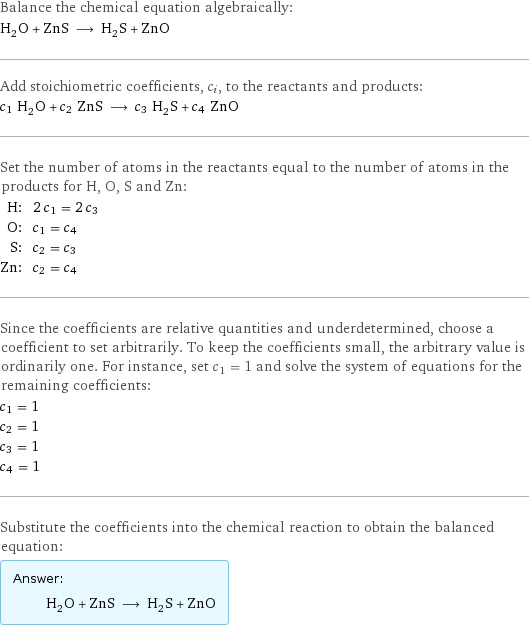
Balance the chemical equation algebraically: H_2O + ZnS ⟶ H_2S + ZnO Add stoichiometric coefficients, c_i, to the reactants and products: c_1 H_2O + c_2 ZnS ⟶ c_3 H_2S + c_4 ZnO Set the number of atoms in the reactants equal to the number of atoms in the products for H, O, S and Zn: H: | 2 c_1 = 2 c_3 O: | c_1 = c_4 S: | c_2 = c_3 Zn: | c_2 = c_4 Since the coefficients are relative quantities and underdetermined, choose a coefficient to set arbitrarily. To keep the coefficients small, the arbitrary value is ordinarily one. For instance, set c_1 = 1 and solve the system of equations for the remaining coefficients: c_1 = 1 c_2 = 1 c_3 = 1 c_4 = 1 Substitute the coefficients into the chemical reaction to obtain the balanced equation: Answer: | | H_2O + ZnS ⟶ H_2S + ZnO
Structures

+ ⟶ +
Names

water + zinc sulfide ⟶ hydrogen sulfide + zinc oxide
Reaction thermodynamics
Enthalpy
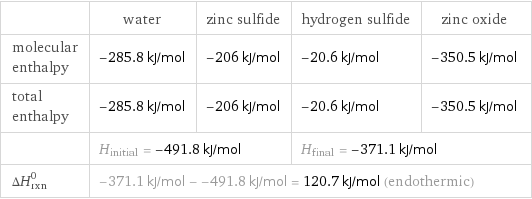
| water | zinc sulfide | hydrogen sulfide | zinc oxide molecular enthalpy | -285.8 kJ/mol | -206 kJ/mol | -20.6 kJ/mol | -350.5 kJ/mol total enthalpy | -285.8 kJ/mol | -206 kJ/mol | -20.6 kJ/mol | -350.5 kJ/mol | H_initial = -491.8 kJ/mol | | H_final = -371.1 kJ/mol | ΔH_rxn^0 | -371.1 kJ/mol - -491.8 kJ/mol = 120.7 kJ/mol (endothermic) | | |
Gibbs free energy
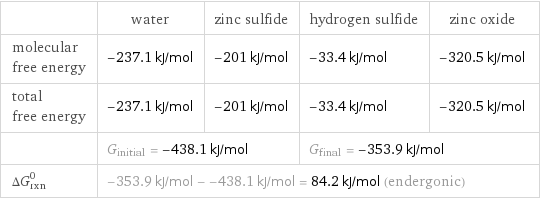
| water | zinc sulfide | hydrogen sulfide | zinc oxide molecular free energy | -237.1 kJ/mol | -201 kJ/mol | -33.4 kJ/mol | -320.5 kJ/mol total free energy | -237.1 kJ/mol | -201 kJ/mol | -33.4 kJ/mol | -320.5 kJ/mol | G_initial = -438.1 kJ/mol | | G_final = -353.9 kJ/mol | ΔG_rxn^0 | -353.9 kJ/mol - -438.1 kJ/mol = 84.2 kJ/mol (endergonic) | | |
Entropy
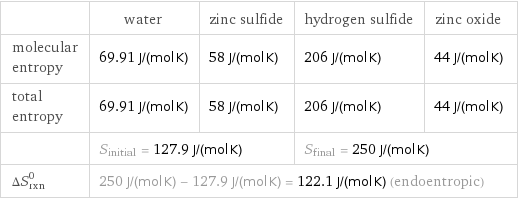
| water | zinc sulfide | hydrogen sulfide | zinc oxide molecular entropy | 69.91 J/(mol K) | 58 J/(mol K) | 206 J/(mol K) | 44 J/(mol K) total entropy | 69.91 J/(mol K) | 58 J/(mol K) | 206 J/(mol K) | 44 J/(mol K) | S_initial = 127.9 J/(mol K) | | S_final = 250 J/(mol K) | ΔS_rxn^0 | 250 J/(mol K) - 127.9 J/(mol K) = 122.1 J/(mol K) (endoentropic) | | |
Equilibrium constant
![Construct the equilibrium constant, K, expression for: H_2O + ZnS ⟶ H_2S + ZnO Plan: • Balance the chemical equation. • Determine the stoichiometric numbers. • Assemble the activity expression for each chemical species. • Use the activity expressions to build the equilibrium constant expression. Write the balanced chemical equation: H_2O + ZnS ⟶ H_2S + ZnO Assign stoichiometric numbers, ν_i, using the stoichiometric coefficients, c_i, from the balanced chemical equation in the following manner: ν_i = -c_i for reactants and ν_i = c_i for products: chemical species | c_i | ν_i H_2O | 1 | -1 ZnS | 1 | -1 H_2S | 1 | 1 ZnO | 1 | 1 Assemble the activity expressions accounting for the state of matter and ν_i: chemical species | c_i | ν_i | activity expression H_2O | 1 | -1 | ([H2O])^(-1) ZnS | 1 | -1 | ([ZnS])^(-1) H_2S | 1 | 1 | [H2S] ZnO | 1 | 1 | [ZnO] The equilibrium constant symbol in the concentration basis is: K_c Mulitply the activity expressions to arrive at the K_c expression: Answer: | | K_c = ([H2O])^(-1) ([ZnS])^(-1) [H2S] [ZnO] = ([H2S] [ZnO])/([H2O] [ZnS])](../image_source/dbe95407529447d9f611697cde075d8a.png)
Construct the equilibrium constant, K, expression for: H_2O + ZnS ⟶ H_2S + ZnO Plan: • Balance the chemical equation. • Determine the stoichiometric numbers. • Assemble the activity expression for each chemical species. • Use the activity expressions to build the equilibrium constant expression. Write the balanced chemical equation: H_2O + ZnS ⟶ H_2S + ZnO Assign stoichiometric numbers, ν_i, using the stoichiometric coefficients, c_i, from the balanced chemical equation in the following manner: ν_i = -c_i for reactants and ν_i = c_i for products: chemical species | c_i | ν_i H_2O | 1 | -1 ZnS | 1 | -1 H_2S | 1 | 1 ZnO | 1 | 1 Assemble the activity expressions accounting for the state of matter and ν_i: chemical species | c_i | ν_i | activity expression H_2O | 1 | -1 | ([H2O])^(-1) ZnS | 1 | -1 | ([ZnS])^(-1) H_2S | 1 | 1 | [H2S] ZnO | 1 | 1 | [ZnO] The equilibrium constant symbol in the concentration basis is: K_c Mulitply the activity expressions to arrive at the K_c expression: Answer: | | K_c = ([H2O])^(-1) ([ZnS])^(-1) [H2S] [ZnO] = ([H2S] [ZnO])/([H2O] [ZnS])
Rate of reaction
![Construct the rate of reaction expression for: H_2O + ZnS ⟶ H_2S + ZnO Plan: • Balance the chemical equation. • Determine the stoichiometric numbers. • Assemble the rate term for each chemical species. • Write the rate of reaction expression. Write the balanced chemical equation: H_2O + ZnS ⟶ H_2S + ZnO Assign stoichiometric numbers, ν_i, using the stoichiometric coefficients, c_i, from the balanced chemical equation in the following manner: ν_i = -c_i for reactants and ν_i = c_i for products: chemical species | c_i | ν_i H_2O | 1 | -1 ZnS | 1 | -1 H_2S | 1 | 1 ZnO | 1 | 1 The rate term for each chemical species, B_i, is 1/ν_i(Δ[B_i])/(Δt) where [B_i] is the amount concentration and t is time: chemical species | c_i | ν_i | rate term H_2O | 1 | -1 | -(Δ[H2O])/(Δt) ZnS | 1 | -1 | -(Δ[ZnS])/(Δt) H_2S | 1 | 1 | (Δ[H2S])/(Δt) ZnO | 1 | 1 | (Δ[ZnO])/(Δt) (for infinitesimal rate of change, replace Δ with d) Set the rate terms equal to each other to arrive at the rate expression: Answer: | | rate = -(Δ[H2O])/(Δt) = -(Δ[ZnS])/(Δt) = (Δ[H2S])/(Δt) = (Δ[ZnO])/(Δt) (assuming constant volume and no accumulation of intermediates or side products)](../image_source/7221c830735f15dbbfb302f9bc459eff.png)
Construct the rate of reaction expression for: H_2O + ZnS ⟶ H_2S + ZnO Plan: • Balance the chemical equation. • Determine the stoichiometric numbers. • Assemble the rate term for each chemical species. • Write the rate of reaction expression. Write the balanced chemical equation: H_2O + ZnS ⟶ H_2S + ZnO Assign stoichiometric numbers, ν_i, using the stoichiometric coefficients, c_i, from the balanced chemical equation in the following manner: ν_i = -c_i for reactants and ν_i = c_i for products: chemical species | c_i | ν_i H_2O | 1 | -1 ZnS | 1 | -1 H_2S | 1 | 1 ZnO | 1 | 1 The rate term for each chemical species, B_i, is 1/ν_i(Δ[B_i])/(Δt) where [B_i] is the amount concentration and t is time: chemical species | c_i | ν_i | rate term H_2O | 1 | -1 | -(Δ[H2O])/(Δt) ZnS | 1 | -1 | -(Δ[ZnS])/(Δt) H_2S | 1 | 1 | (Δ[H2S])/(Δt) ZnO | 1 | 1 | (Δ[ZnO])/(Δt) (for infinitesimal rate of change, replace Δ with d) Set the rate terms equal to each other to arrive at the rate expression: Answer: | | rate = -(Δ[H2O])/(Δt) = -(Δ[ZnS])/(Δt) = (Δ[H2S])/(Δt) = (Δ[ZnO])/(Δt) (assuming constant volume and no accumulation of intermediates or side products)
Chemical names and formulas
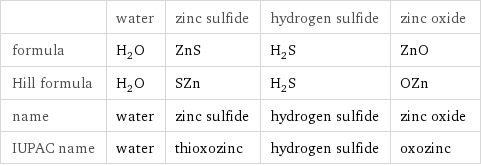
| water | zinc sulfide | hydrogen sulfide | zinc oxide formula | H_2O | ZnS | H_2S | ZnO Hill formula | H_2O | SZn | H_2S | OZn name | water | zinc sulfide | hydrogen sulfide | zinc oxide IUPAC name | water | thioxozinc | hydrogen sulfide | oxozinc
Substance properties
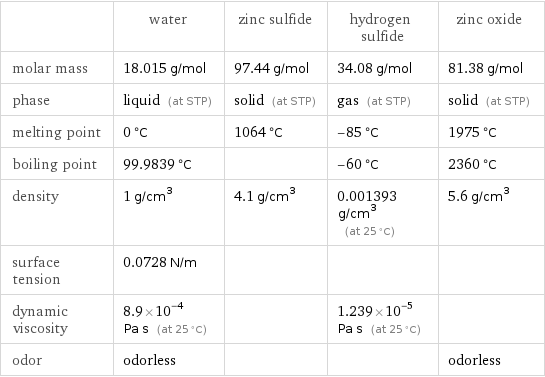
| water | zinc sulfide | hydrogen sulfide | zinc oxide molar mass | 18.015 g/mol | 97.44 g/mol | 34.08 g/mol | 81.38 g/mol phase | liquid (at STP) | solid (at STP) | gas (at STP) | solid (at STP) melting point | 0 °C | 1064 °C | -85 °C | 1975 °C boiling point | 99.9839 °C | | -60 °C | 2360 °C density | 1 g/cm^3 | 4.1 g/cm^3 | 0.001393 g/cm^3 (at 25 °C) | 5.6 g/cm^3 surface tension | 0.0728 N/m | | | dynamic viscosity | 8.9×10^-4 Pa s (at 25 °C) | | 1.239×10^-5 Pa s (at 25 °C) | odor | odorless | | | odorless
Units
